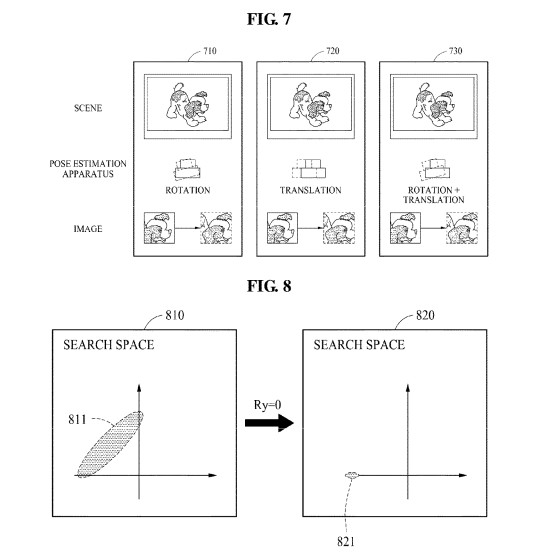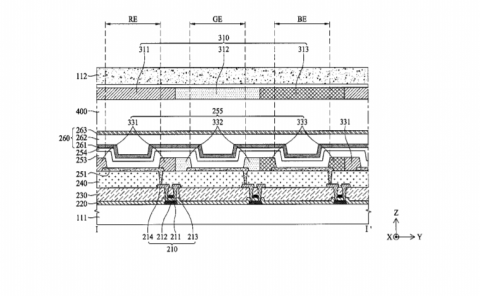Samsung Patent | Pose estimation method and apparatus
Patent: Pose estimation method and apparatus
Publication Number: 10198824
Publication Date: 2019-02-05
Applicants: Samsung

Abstract
A pose estimation method and apparatus are provided. The method includes determining, as a rotation component, an output value of a motion sensor configured to sense a motion of the pose estimation apparatus, determining a change amount of a translation component based on the rotation component, and the translation component extracted from images photographed by a vision sensor included in the pose estimation apparatus, optimizing the translation component based on the change amount, and outputting the rotation component and the optimized translation components a pose estimation value of the pose estimation apparatus.
Background
A pose estimation of a camera may determine translation and rotation information on a dynamically changing camera viewpoint. The pose estimation of a camera may be increasingly utilized in fields of simultaneous localization and map building (SLAM), mixed reality, augmented reality, robot navigating, and three-dimensional (3D) scene reconstruction.
Summary
According to an aspect of an exemplary embodiment, there is provided a pose estimation method performed by a pose estimation apparatus, the method comprising determining, as a rotation component, an output value of a motion sensor configured to sense a motion of the pose estimation apparatus; determining a change amount of a translation component based on the rotation component, and the translation component extracted from images photographed by a vision sensor included in the pose estimation apparatus, and optimizing the translation component based on the change amount; and outputting the rotation component and the optimized translation component as a pose estimation value of the pose estimation apparatus.
The output value of the motion sensor may comprise motion information on a rotation angle of the pose estimation apparatus.
The rotation component may be constantly maintained to be the output value of the motion sensor while the translation component is optimized.
A change amount of the rotation component may be set to be 0, or a rotation component of a Jacobian matrix used to determine the change amount of the translation component may be set to be 0.
The optimizing of the translation component may comprise determining the change amount of the translation component based on the rotation component and the translation component in a previous operation, and determining a translation component in a current operation from the translation component in the previous operation based on the change amount of the translation component; verifying whether additional optimization with respect to the translation component in the current operation is requested; and determining the translation component in the current operation as the optimized translation component when the additional optimization with respect to the translation component in the current operation is not requested.
The verifying may comprise verifying that the additional optimization is not requested when the change amount of the translation component is less than a threshold amount, or when an error rate in the current operation is greater than an error rate in the previous operation.
The method may further comprise determining the output pose estimation value, and determining a fusion pose estimation value of the pose estimation apparatus by applying a sensor fusion scheme with respect to the pose estimation value of the pose estimation apparatus determined based on motion information on the motion of the pose estimation apparatus output from the motion sensor.
The determining of the output value of the motion sensor as the rotation component may comprise verifying whether the output value of the motion sensor is determined as the rotation component based on at least one of a reliability of the output value of the motion sensor, whether the output value of the motion sensor exists, and an initialization condition of the motion sensor.
The vision sensor may be an event-based vision sensor configured to asynchronously generate an event signal in response to an event in which a light received from an object is changed; or a frame-based vision sensor configured to synchronously photograph the object according to a number of frames per second.
The translation component may comprise information on a translation distance of the pose estimation apparatus based on an x-axis, a y-axis, and a z-axis, and the rotation component comprises information on a rotation angle of the pose estimation apparatus based on the x-axis, the y-axis, and the z-axis.
According to another aspect of an exemplary embodiment, there is provided a non-transitory computer-readable recording medium which stores a program to implement a method comprising determining, as a rotation component, an output value of a motion sensor configured to sense a motion of the pose estimation apparatus; determining a change amount of a translation component based on the rotation component, and the translation component extracted from images photographed by a vision sensor included in the pose estimation apparatus, and optimizing the translation component based on the change amount; and outputting the rotation component and the optimized translation component as a pose estimation value of the pose estimation apparatus.
According to another aspect of an exemplary embodiment, there is provided a pose estimation apparatus comprising a motion sensor configured to sense a motion of the pose estimation apparatus; a vision sensor configured to photograph a foreground of the pose estimation apparatus; and a processor configured to estimate a pose of the pose estimation apparatus, wherein the processor is configured to determine, as a rotation component, an output value of the motion sensor, determine a change amount of a translation component based on the rotation component, and the translation component extracted from images photographed by the vision sensor, optimize the translation component based on the change mount, and output the rotation component and the optimized translation component as a pose estimation value of the pose estimation apparatus.
The output value of the motion sensor may comprise motion information on a rotation angle of the pose estimation apparatus.
The rotation component may be constantly maintained to be the output value of the motion sensor while the translation component is optimized.
The processor may be configured to determine the change amount of the translation component based on the rotation component and a translation component in a previous operation, determine a translation component in a current operation from the translation component in the previous operation, verify whether additional optimization with respect to the translation component in the current operation is requested, and determine the translation component in the current operation as the optimized translation component when the additional optimization with respect to the translation component is not requested.
The processor may be configured to verify that the additional optimization is not requested when the change amount of the translation component is less than a threshold amount, or when an error rate in the current operation is greater than an error rate in the previous operation.
The processor may be configured to determine the output pose estimation value and a fusion pose estimation value of the pose estimation apparatus by applying a sensor fusion scheme with respect to the pose estimation value of the pose estimation apparatus determined based on motion information on the motion of the pose estimation apparatus output from the motion sensor.
The processor may be configured to verify whether the output value of the motion sensor is determined as the rotation component based on at least one of a reliability of the output value of the motion sensor, whether the output value of the motion sensor exists, and an initialization condition of the motion sensor.
The vision sensor may be an event-based vision sensor configured to asynchronously generate an event signal in response to an event in which a light received from an object is changed; or a frame-based vision sensor configured to synchronously photograph the object according to a predetermined number of frames per second.
The translation component may comprise information on a translation distance of the pose estimation apparatus based on an x-axis, a y-axis, and a z-axis, and the rotation component comprises information on a rotation angle of the pose estimation apparatus based on the x-axis, the y-axis, and the z-axis.
According to another aspect of an exemplary embodiment, there is provided a pose estimation method performed by a pose estimation apparatus, the method comprising in a first stage, setting a rotation angle from a motion sensor of the pose estimation apparatus, as a rotation component of a pose of the pose estimation apparatus, and determining a change amount of a plurality of images from a vision sensor of the pose estimation apparatus, as a translation component of a pose of the pose estimation apparatus; in one or more subsequent stages, iteratively optimizing the translation component based on a translation component from a prior stage, while holding a change amount of the rotation component constant; and outputting the rotation component and the optimized translation component of the pose of the pose estimation apparatus.
The constant may be 0.
The translation component may be iteratively optimized until a termination condition for the optimization is reached.
The termination condition may occur when a change amount of the translation component is less than a threshold amount or when an error rate with respect to the translation component and a rotation component determined in a current stage is greater than an error rate with respect to the translation component and a rotation component in a prior stage.
The translation component may be a degree of movement of the pose estimation apparatus with respect to an x axis, a y axis, and a z axis, and the rotation component may be a degree of rotation of the pose estimation apparatus with respect to the x axis, the y axis and the z axis.



